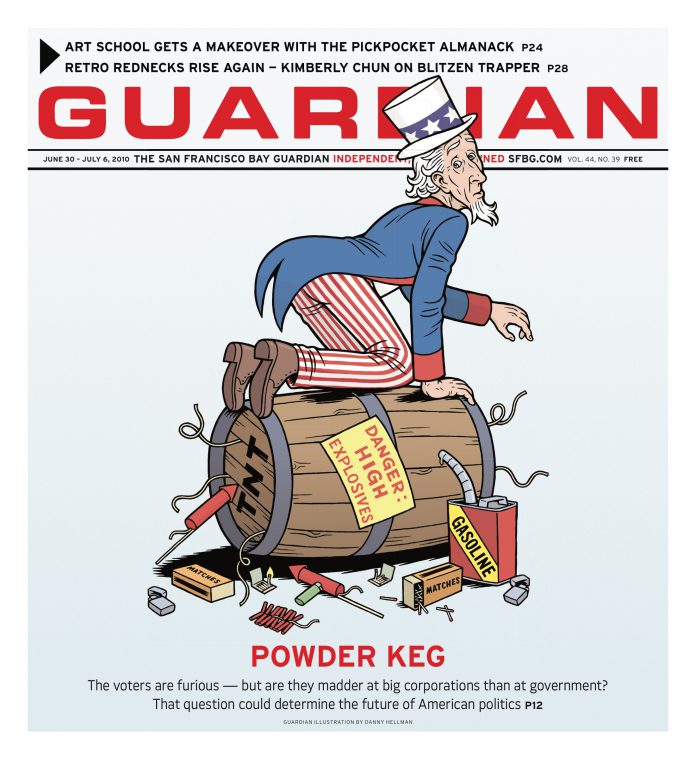steve@sfbg.com
GREEN CITY San Francisco can legally give more street space to bicycles, even if it delays cars or Muni in some spots, a policy that enjoys universal support among elected officials here. So why have all the city’s proposed bike projects been held up by an unprecedented four-year court injunction, despite the judge’s clear affirmation of the city’s right to approve its current Bicycle Plan as written?
The answer involves a mind-numbing journey into the complex strictures of the California Environmental Quality Act and its related case law, which was the subject of a three-hour hearing before Superior Court Judge Peter Busch on June 22 that delved deeply into transportation engineering minutiae but did little to indicate when the city might be able to finally stripe the 45 bike lanes that have been studied, approved, funded, and are ready to go.
Anti-bike activist Rob Anderson and attorney Mary Miles have been on a long and lonely — but so far, quite successful — legal crusade to kill any proposed bike projects that remove parking spaces or cause traffic delays. They have argued that the city shouldn’t be allowed to hurt the majority of road users to help the minority who ride bikes, urging the city and court to remove those projects from the Bike Plan.
But Busch repeatedly said the court can’t do that. “That’s the policy question that’s not for the court to decide,” he told Miles in court, later adding: “I don’t get to decide that the Board of Supervisors’ policy is misguided.”
Yet city officials have offered detailed arguments that the policy of facilitating safe bicycling isn’t misguided, but instead is consistent with the transit-first policy in the city charter and with the goals of reducing greenhouse gas emissions, improving public health, and even alleviating overall traffic congestion by giving more people good alternatives to driving a car.
Busch hasn’t indicated that he has any issues with that rationale. Instead, the question is whether policymakers had enough information — in the proper manner spelled out by two generations’ worth of legal battles over land use decisions in California — to make their unanimous decisions to approve the Bike Plan in 2005 and again in 2009, after completing a court-ordered, four-volume, two-year, $2 million environmental impact report.
Miles argues that the EIR is legally inadequate in every way possible, employing such gross hyperbole in condemning it as a hollow document that does nothing to explain or justify any of its conclusions that Busch told her at one point, “That’s such an over-argument, it leaves me wondering about the rest of your argument.”
But he’s certainly considering the rest of her argument that more analysis was required, going into great detail on the questions of whether the city studied and spelled out enough alternatives and mitigation measures, how much of the voluminous traffic survey data should be in the plan, whether there was enough support for the thresholds of significant impacts, and what the remedy should be if he finds some minor errors in the methodology.
Yet even Busch said there wasn’t a clear regulatory road map for the city to follow on this project. “There probably has never been an EIR for a project like this,” he acknowledged. It was the city’s decision in 2004 to do a Bike Plan that mentioned specific projects without studying them that led to the injunction and this extraordinarily complex EIR, which did detailed analysis on more than 60 projects.
“Once you get that complexity, the toeholds are everywhere to fight it,” activist Mark Salomon, who has long criticized city officials and bicycle activists for their approach to the Bike Plan, told us.
But Kate Stacey, who heads the land use team in the City Attorney’s Office, says the city will be in a good position to quickly create lots of bike lanes once this plan passes legal muster.
“The city can now go through the specific bike projects without having another step of analysis,” she told us. “I think it’s a complete and elegant approach even if it was more time-consuming at the outset.” Busch asked both sides to submit proposed orders by July 6 and responses to those orders by July 13, with a ruling and possible lifting of the injunction expected later this summer.

